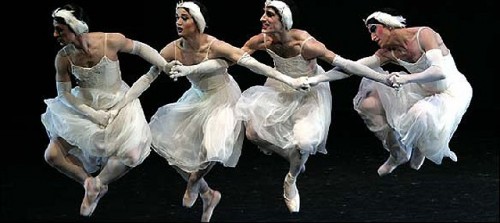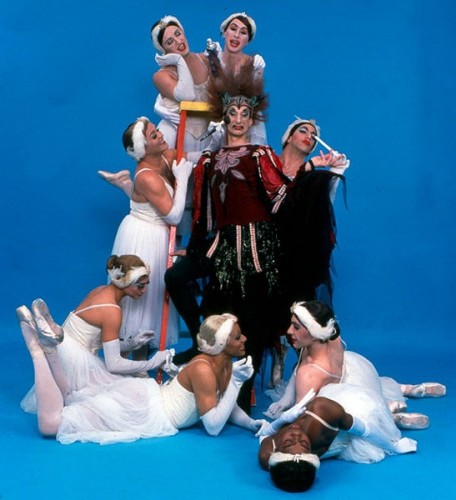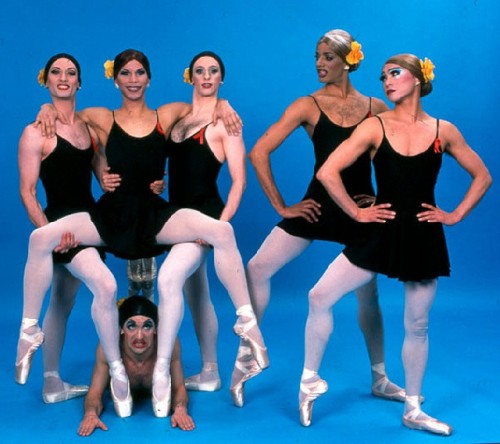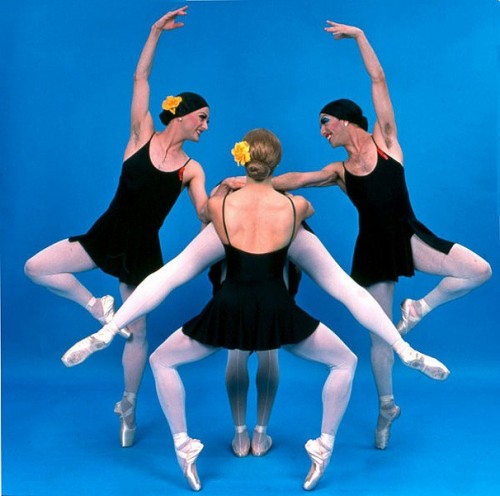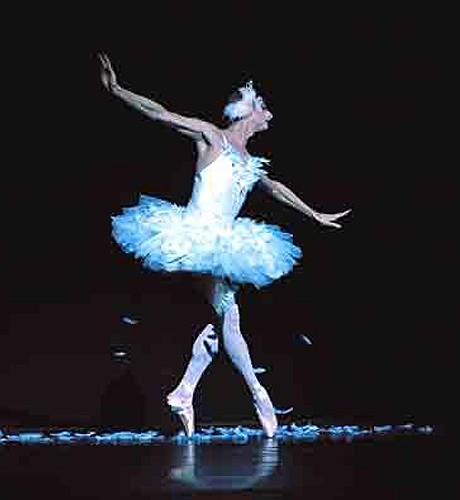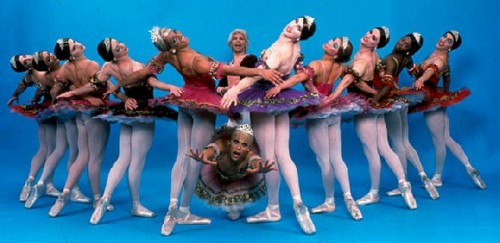Mass MoCA and Jacob's Pillow Bring Les Ballets Trockadero to North Adams
Little Girls Aren't the Only Ones Who Dream of Becoming Ballerinas
By: Larry Murray - Oct 11, 2008
Last night Les Ballets Trockadero de Monte Carlo bourréed into North Adams. That a louche troupe of cross dressing ballerinas were ensconced at the Hunter Center of Mass MoCA marks a milestone in the development of this city. (Thankfully it also escaped the notice of the troublesome segment of Topix commentators in the North Adams Transcript and Berkshire Eagle.) Except for MoCA's long time volunteers who once worked in these former factories, the other mill rats were blissfully oblivious.
Their regal highnesses, the clown prices of ballet, the Prima Ballerinas of Tockadero de Monte Carlo, are in no danger of being ignored however. Their performances are virtually sold out. Word travels fast in the Berkshires, especially if a company is both high art and low comedy. This company, founded in 1974, more than fulfills that role. They are a dance phenomenon that is popular around the world.
The "Trocks" as they are known are the keepers of the flame of the great story ballets of Tchaikovsky and Ivanov. At the same time, they are anarchists who challenge the uniformity of Balanchine, and sees that the Emperor has no clothes when they take on a threadbare Merce Cunningham dance "as long as they don't change one single movement". In a way, the company believes that the only icons worth remembering are those who are ripe and ready for parody.
Thus the program was filled with the cream of ballets, alternately whipped and curdled. Their signature piece, Act II of Swan Lake opened the program, followed by a Keystone Kops version of Concerto Barocco holding the middle, and Fokine's Paquita at the end. In between we are able to enjoy a Dying Swan and a satirical Don Quixote pas de deux that even Sasha (Rudolph Nureyev) would have laughed at.
It has been two decades since I last saw this troupe, and it is clear that the level of dance proficiency and expertise has skyrocketed. This is likely attributable to Artistic Director Tory Dobrin, who danced with the Trocks for many years before assuming leadership. He and Ella Baff from Jacob's Pillow held an informal discussion with last night's audience following the performance. One of the things we learned is that this is a company that pays its bills through ticket sales. They tour 30 weeks a year.
That these visions in white tulle were more giraffe than gazelle made little difference to the telling of the story of Swan Lake. The hunters and the swan-boys hunted, hid and fell in love just as Tchaikovsky-Ivanov planned, with delicious digressions and digs at balletic pantomime! Anyone who attends ballet regularly knows the use of mime in ballet to advance the story has always been an embarrassment. The florid gestures are more Comedy Store than ASL for Beginners.
Much of this Swan Lake was spent with Odette (Larriska Dumbchenko) arguing with Benno (Boris Notwitksky) and Prince Sigried (Ashley Romanof-Titwillow) over who is falling in love with whom. Yuri Smirov as Von Rothbart did not help much by constantly turning girls into more swans. In all, it was a delightful high-camp exercise in phantasmagorical cross-species and gender bending metamorphosis. And all this nonsense fascinated 19th Century Russians as much as 21st Century American audiences.
Go For Barocco is both a tribute and a commentary on George Balanchine and is based on perhaps his best known work, Concerto Barocco. Balanchine only hired long, thin dancers with small heads and unpadded bodies, and thus developed a look for his company which was uniform. Individually the dancers all had unique personalities, just as in A Chorus Line, but when costumed in Middle-Blue-Verging-On-Black-and-White unitards, they end up being interchangeable. In this dance, set to music by J.S. Bach, the Trock's seditious choreographer Peter Anastos applies these standards to dancers who range from elephantine to rat-dog size.
One of the funniest takes on Balanchine are the power walking sequences. The Trocks transform this neo-classic dance into a new and more spontaneous art form. It reminded me of knot tying classes. The dancers moved in, over, and through each other in a series of increasingly obtuse combinations. William Vanilla easily stood out, often going in the opposite direction of the formal lines, and reducing the audience to hysterics.
Michel Fokine created the most exquisite and sensitive choreography for Pavlova when he created The Dying Swan to the music of Camille Saint-Saens. It was clear that this work was in trouble when it was undertaken by Paul Ghiselin, dancing under his nom de plume of Ida Nevasayneva. Like a skywriting plane, he leaves a trail of down in his wake, having filled his tutu with thousands of the fluffiest feathers beforehand. And how his spindly legs make this terminal fowl look as emaciated as any anorexic ballerina that ever lived. This swan's death might have been forestalled by a forcefully administered Snickers bar. In the end, her pathetic passing was as inevitable as it was temporary. All it took was a little applause, and this departed swan was back on her feet, milking the audience for all it was worth.
The most balletic of the offerings was Paquita which utilized the entire company of 14. Here the corps de ballet was truly dancing for long stretches before introducing the comedic elements. The joy of their dancing was similar to that one might feel when Victor Borge stopped joking and played an etude from beginning to end. Of course, the French style choreography - later adapted by Petipa for Russian audiences - is too rich a vein to leave untapped.
This is a Paquita with some original moves, like the two-man lift and the "slightly assisted" ponche. Yes some ballerinas were just too heavy for one man to lift. And for the latter dance move, one foot is en pointe on the floor while the other leg points straight up, with the dancer's toes pointing at twelve noon. In dance school, all the girls master it, but the boys, absolutely never. Since it is such an unnatural position for the men, it took a helping hand to come anywhere close to accomplishing it, the best being perhaps" ten minutes before" noon. For the pas de deux, the ballerina was much larger than the danseur, and this made for rough landings which reverberated with a thud and "fish dives" that appeared more like belly flops.
Paquita was alternately brilliant dancing with allegro arabesques and far flung extensions and enough ad-libbed movements for an improv exercise. Each dancer had several turns in the spotlight and the piece turned into a bit of a competition which of course delighted the audience, and perhaps surprised each other. Petipa would have been proud.
If there is any criticism to be made, it is that for all the attention paid to the women's roles, much less was paid for the men. In the Don Quixote duet, the grand jete's were pretty much earthbound. Certainly, having seen Nureyev in this role sets a pretty high standard, and despite the applause, the men's roles need more high altitude training.
Technically the show was a masterpiece. For a traveling company that dances on a different stage almost every night, perfection is rare. All the more reason to be impressed that the lighting cues and costume changes functioned with nary a bump along the way. The show was so polished it looked as if they had settled in for a long run. A large portion of the credit has to go to the unsung heroes of Mass MoCA, the tech crew which constantly meets the challenges of these touring companies with professionalism. It shows.
I haven't had such a good time at Mass MoCA since The Tiger Lillies appeared there several years ago. Let's hope those who plan these events keeps in mind that this weekend there are full houses for an attraction that is both unusual and yet easily accessible to anyone, art lover to tv-watcher. Best of all, there were an incredible number of teens and younger people in the audience.
When the Trocks first set out, the idea that men would dress en travesti (in drag) was controversial.
Today, they are just good entertainment. The times have changed, for the better.

